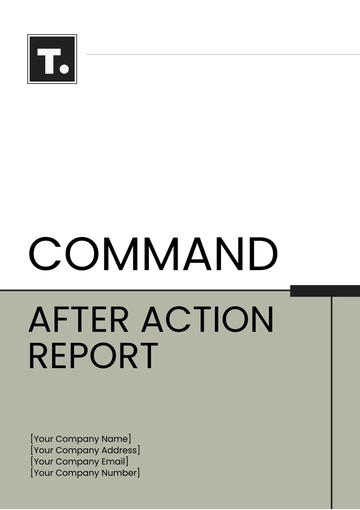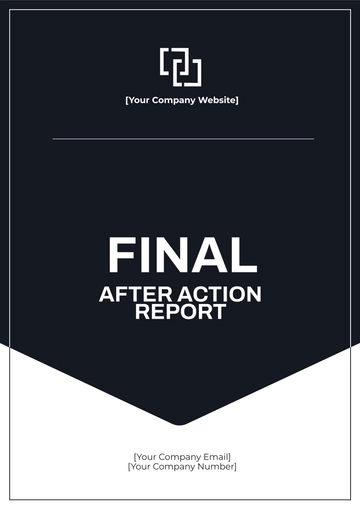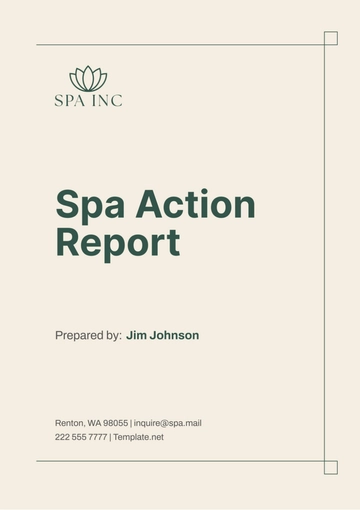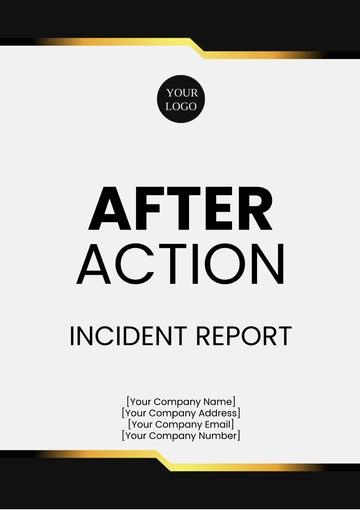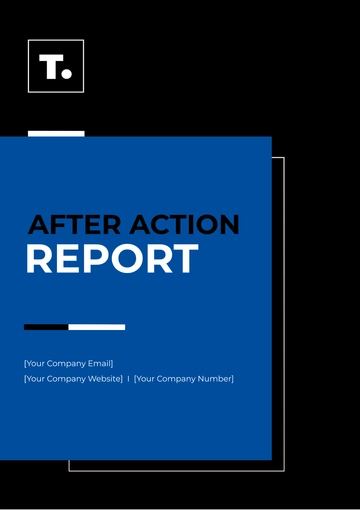Free After Action Incident Report
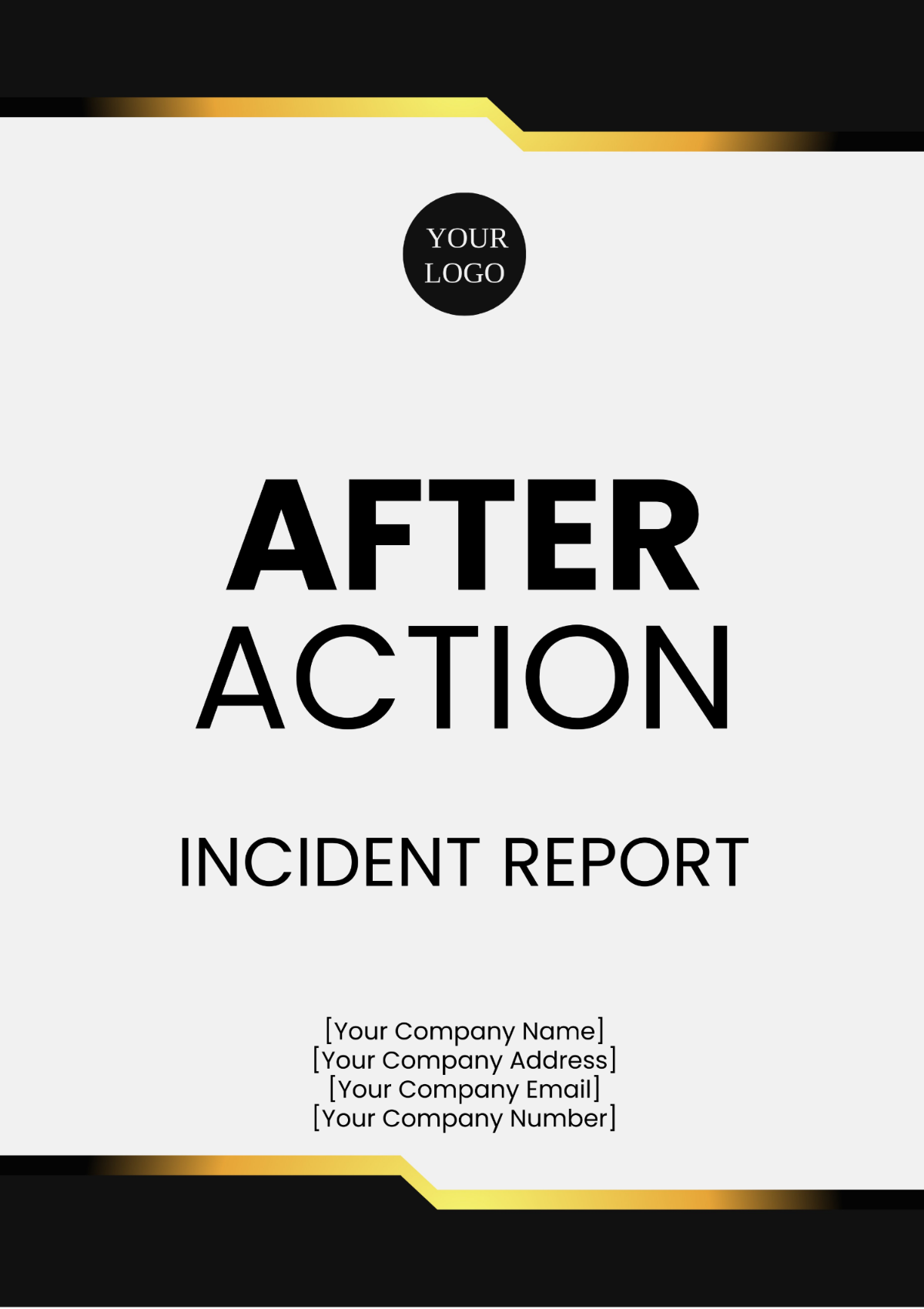
I. Incident Overview
Incident Title: Fire Incident
Date of Incident: May 15, 2050
Reported On: May 20, 2050
Incident Location: [YOUR COMPANY ADDRESS]
Organization: [YOUR COMPANY NAME]
Prepared by: [YOUR NAME]
II. Executive Summary
On May 15, 2050, at approximately 10:30 AM, a fire broke out in the storage facility of [YOUR COMPANY NAME] in [YOUR COMPANY ADDRESS]. The fire resulted in significant property damage but, fortunately, no injuries. The company's emergency response team and local fire services led the response. Key findings indicate that while the initial response was prompt, there were delays due to inadequate access to fire suppression systems. Recommendations include upgrading fire suppression systems, conducting regular fire drills, and improving communication protocols.
III. Introduction
A. Purpose
This report aims to analyze the incident, evaluate the response actions, identify strengths and weaknesses, and provide recommendations to prevent future incidents.
B. Incident Summary
On May 15, 2050, a fire started in the storage facility of [YOUR COMPANY NAME]. The fire was caused by an electrical fault in one of the storage racks. The fire alarm was triggered, and the facility was evacuated promptly. The local fire department arrived on the scene within 15 minutes and managed to contain the fire after two hours.
C. Events Leading Up to the Incident
Routine operations were being conducted in the storage facility.
An electrical fault occurred in a storage rack, igniting nearby flammable materials.
The fire spread quickly, triggering the fire alarm system.
IV. Response Actions
A. Initial Response
10:30 AM: Fire alarm triggered, and facility evacuation initiated.
10:35 AM: Emergency response team assembled at the designated muster point.
10:40 AM: The local fire department was notified and dispatched to the scene.
B. Fire Department Response
10:45 AM: First fire engine arrived on site.
10:50 AM: Firefighters began firefighting operations.
12:45 PM: Fire contained and declared under control.
C. Involved Personnel
[YOUR COMPANY NAME] Emergency Response Team
Springfield Fire Department (Station 4)
Facility Manager: [FACILITY MANAGER NAME]
V. Analysis of Actions
A. What Worked Well
Prompt evacuation of the facility prevented injuries.
The emergency response team assembled quickly and provided accurate information to firefighters.
The local fire department's timely arrival and effective firefighting tactics contained the fire.
B. What Did Not Work Well
Inadequate fire suppression systems in the storage facility delayed containment.
Difficulty accessing certain areas due to storage layout hindered firefighting efforts.
Initial confusion in communication between the emergency response team and the fire department.
VI. Findings and Lessons Learned
A. Strengths
Effective evacuation procedures ensured no injuries.
Quick assembly and cooperation of the emergency response team facilitated the response.
B. Weaknesses
Fire suppression systems were not sufficient for the size and contents of the storage facility.
Storage layout created barriers to firefighting efforts.
Communication protocols need improvement to ensure clarity and efficiency.
VII. Recommendations
Upgrade Fire Suppression Systems
Install advanced fire suppression systems suitable for the materials stored.
Conduct regular maintenance and testing of these systems.
Conduct Regular Fire Drills
Implement biannual fire drills to ensure all personnel are familiar with evacuation procedures.
Include coordination with local fire departments in the drills.
Improve Communication Protocols
Develop a clear communication plan for emergency situations.
Provide training on effective communication during crises.
Reevaluate Storage Layout
Optimize the storage facility layout to ensure clear access for emergency responders.
Implement fire-resistant storage solutions for flammable materials.
VIII. Conclusion
The incident at [YOUR COMPANY NAME] highlighted the importance of robust fire safety measures and effective communication during emergencies. While the prompt evacuation and quick response from the fire department were commendable, the inadequacies in fire suppression systems and communication protocols need to be addressed. Implementing the recommended improvements will enhance the facility's preparedness and response capabilities, reducing the risk of future incidents.
IX. Appendices
Appendix A: Timeline of Events
Time | Event |
|---|---|
10:30 AM | Fire alarm triggered |
10:35 AM | Evacuation initiated |
10:40 AM | Emergency response team assembled |
10:45 AM | Fire department arrived |
10:50 AM | Firefighting operations began |
12:45 PM | Fire contained |
This report serves as a comprehensive analysis of the incident, aiming to improve future responses and enhance safety protocols at [YOUR COMPANY NAME].
- 100% Customizable, free editor
- Access 1 Million+ Templates, photo’s & graphics
- Download or share as a template
- Click and replace photos, graphics, text, backgrounds
- Resize, crop, AI write & more
- Access advanced editor
Capture essential details of any incident with Template.net’s After Action Incident Report Template. Fully customizable and editable in our AI Editor Tool, this template allows you to document events, responses, and outcomes thoroughly. Enhance your incident reporting process with this structured and easy-to-use tool. What are you waiting for, download it now!
You may also like
- Sales Report
- Daily Report
- Project Report
- Business Report
- Weekly Report
- Incident Report
- Annual Report
- Report Layout
- Report Design
- Progress Report
- Marketing Report
- Company Report
- Monthly Report
- Audit Report
- Status Report
- School Report
- Reports Hr
- Management Report
- Project Status Report
- Handover Report
- Health And Safety Report
- Restaurant Report
- Construction Report
- Research Report
- Evaluation Report
- Investigation Report
- Employee Report
- Advertising Report
- Weekly Status Report
- Project Management Report
- Finance Report
- Service Report
- Technical Report
- Meeting Report
- Quarterly Report
- Inspection Report
- Medical Report
- Test Report
- Summary Report
- Inventory Report
- Valuation Report
- Operations Report
- Payroll Report
- Training Report
- Job Report
- Case Report
- Performance Report
- Board Report
- Internal Audit Report
- Student Report
- Monthly Management Report
- Small Business Report
- Accident Report
- Call Center Report
- Activity Report
- IT and Software Report
- Internship Report
- Visit Report
- Product Report
- Book Report
- Property Report
- Recruitment Report
- University Report
- Event Report
- SEO Report
- Conference Report
- Narrative Report
- Nursing Home Report
- Preschool Report
- Call Report
- Customer Report
- Employee Incident Report
- Accomplishment Report
- Social Media Report
- Work From Home Report
- Security Report
- Damage Report
- Quality Report
- Internal Report
- Nurse Report
- Real Estate Report
- Hotel Report
- Equipment Report
- Credit Report
- Field Report
- Non Profit Report
- Maintenance Report
- News Report
- Survey Report
- Executive Report
- Law Firm Report
- Advertising Agency Report
- Interior Design Report
- Travel Agency Report
- Stock Report
- Salon Report
- Bug Report
- Workplace Report
- Action Report
- Investor Report
- Cleaning Services Report
- Consulting Report
- Freelancer Report
- Site Visit Report
- Trip Report
- Classroom Observation Report
- Vehicle Report
- Final Report
- Software Report






